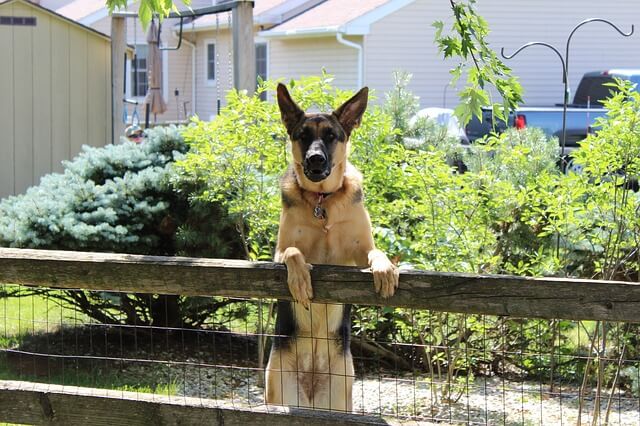
You want to protect your pet – from running into the street, from getting out of your yard, from ruining your garden. Wireless pet fences are one common way of doing just that. These invisible fences offer a safe play area for your dog or other pet without compromising the look of your yard.
Before Installing a Wireless Pet Fence
Before buying and installing a wireless pet fence, there are some important considerations.
Wireless vs. Wired
It is critical to understand the differences between pet fences with wires and pet fences without wires. A wireless pet fence does nor require any part of the system to be buried under the ground. Instead, a transmitter is placed at the center of the area you want your pet to be able to access while wearing the receiving collar.
A wired pet fence, on the other hand, requires a wire to be buried underground to delineate the area of your property that your pet can access. A wired pet fence may also require professional set up, demarcation of underground utilities and obstacles, and detailed set up to avoid signal and electricity issues.
Pros and Cons of wireless pet containment systems

The first consideration is your pet. Wireless pet fences do not always work; some animals will ignore the “corrections” from the connected collar and run through the fence anyway. It is also possible that your pet will become irritable, fearful, or even aggressive since the “corrections” – usually mild shocks or sounds – are uncomfortable and even painful for him or her. Veterinarians also recommend that wireless fences not be used on young puppies under six months old.
The connected collar also must be removed when the pet reenters the house, as the electric signal can be affected by electronics in the household. These collars tend to be large and heavy and usually cannot be used for smaller pets.
Even if the wireless electric fence does not upset or harm your pet,, use of the fence requires a long training process. The dog or other pet has to learn to associate the corrective shocks or sounds with trying to leave the fenced-in area.
A second consideration is your property. Lots of trees, slopes, or terracing can interrupt the fence’s electrical signal, rendering it useless. Wireless fences are best suited to an open, flat area and cannot be used near homes that have mobile phone signal boosters or smart meters. If the fence is suited to your yard, it is easier to install and less prone to damage than a wired fence.
In general, wireless pet fencing options are cheaper than wired options. Installation is also cheaper and easier, since it is not necessary to hire a professional to do the installation. The signals of wireless pet fences are, however, more predisposed to issues like wobbling and interference. GPS-based wireless fencing systems are not as likely to experience interference, but they are much more expensive than a standard wireless pet fence.
Different Wireless Fence Models and Brands
There is a general consensus that the PetSafe Wireless Containment System is the best on the market.
This wireless electric fence is long range and combines the technologies of both wireless and wired pet fences. It is very customizable, with size expansions available for larger spaces and the option to add collars to the system if your family adds more pets to the home.
This system is lightweight and even portable, meaning you can take it with you if your family goes on vacation with your beloved pet. The PetSafe collar boasts adjustable levels of shock “corrections” as well as a sound-only training mode.
The well-trusted brand PetSafe also offers two other wireless fencing options: the Stay + Play Wireless Fence, the Stubborn Dog Fence without Wire, and the Wireless Fence PIF-300.
These options have the same features as the Wireless Containment System. Setting them apart, the Stubborn Dog has a vibration setting for hearing-impaired pets, and the Stay + Play is suitable for small pets about five pounds. The Stubborn Dog is even great for those with a tighter budget, costing about sixty dollars less than other PetSafe options.
Other wireless fences with great reviews include the Sit Boo-Boo Secure-Pet Wireless Fence and Containment System, the Groovypets Remote Training Dog Collar & Inground Electronic Containment Fence System, the SportDog Invisible Dog Fence, and the Havahart Radial-Shape Select Fence.
Planning and Installation
Remember: a pro of a wireless pet fence is that you will not need a professional to install it for you. Installation is relatively quick and easy, and it does not require digging up your yard, marking or moving utilities and obstacles, or learning how to properly bury a wire underground. Professional installation also costs a good amount of money; with a wireless pet fence, you avoid paying this extra fee. This is an added bonus, since wireless fences themselves are already cheaper than alternative wired options.
The first step in planning the installation of your pet fence is to figure out your layout. Figure out the shape and size of the area you want your wireless transmitter to cover before purchasing a system, as different systems have different capabilities. Once you have purchased the system of your choice, it is time to fit the system to your specific space. Most wireless fencing systems cover a circular area with the transmitter at the center of the circle. The inside of the circle is the roaming area for your pet. This is important to realize if you plan to use the wireless fence to keep your pet out of specific parts of your yard, such as a garden or a pool. Different systems also cover different area sizes. Some have adjustable roaming area sizing.
Next, decide where to place your transmitter. The transmitter marks the exact center of your pet’s circular roaming area. That circular roaming area will be different sizes depending on the fence you have chosen.
Here is what to keep in mind when choosing a place for your wireless transmitter:
- The transmitter must be powered by a power outlet, so there must be one near the spot where you choose to place your central transmitter.
- Although the transmitter can send signals through walls, the more obstacles the signal has the weaker it will be. It is optimal to place your transmitter along an outer wall if you are placing it indoors.
- Large metal appliances should be kept three to five feet away from the central transmitter to avoid signal interference.
- The transmitter should be installed on the ground floor of your house between three and five feet off of the ground.
- Keep the number of walls, metal appliances, trees, thick bushes, cars, garagages, and other obstacles between the transmitter and the roaming area perimeter at a minimum.
- Do not place the transmitter in a spot where there is a large downward slope between it and the roaming area perimeter. The best way to check this is to look at where the perimeter will be from where the transmitter will be; if you cannot see the perimeter with your eyes from the proposed location of the transmitter, the signal will not be able to reach it either.
Following these rules will allow your fencing system to do its job and give you peace of mind that your fence is working and your pet is safe enjoying your yard.
Most pet owners will automatically want to place the transmitter indoors for convenience and centralization of the pet roaming space. It is important to be aware of whether or not your transmitter is waterproof and weatherproof if you want to place it outdoors.
How To Properly Use Pet Collar Receiver

The next steps in installation of your pet fence focus on the receiving collar for your pet. Proper setup and use of the collar is integral to proper use of the wireless fencing system.
The first step is to connect the receiver collar. First, be aware of what kind of battery your wireless model’s receiving collar uses. Some use disposable batteries, and some use rechargeable batteries. You should also be aware of whether your collar requires “registration” or is automatic. The instructions of the wireless model should specify this and should also specify, if the collar needs to be “registered,” how to do so. Usually “registering” the collar is similar to syncing a bluetooth device. You will usually just have to approach the transmitter, hit a few buttons on the collar, and wait a few seconds.
Before testing the collar and putting it on your pet, make sure it is on.
Next, test the receiver collar. This step involves setting the radius of your pet’s roaming area and setting the correction level of the collar. Different fencing models have different ways of setting the roaming area radius. To set up the radius and test the collar you will likely need two people. One person should stand where you want the roaming area radius to be and hold the collar at the same height it would be at if your pet were wearing it. Make sure the collar is turned on. The other person should change the radius of the roaming area until it matches where you want the roaming area’s perimeter to be and the collar starts beeping. As soon as the collar beeps, the radius should stop being changed. Setting the correction level of the collar refers to setting the strength of the shock or tone that the collar delivers when your pet gets too close to the roaming area perimeter. The steps to set this differ depending on the model. In some models, there is a “mode” button on the collar used to set the correction level. In other models the correction level must be set directly from the central transmitter.
Finally, put the receiver collar on your pet and adjust the correction level of the collar. Make sure your pet is sitting in a comfortable position when you put the collar on them. Place the collar on your pet with the receiver facing forward, and test that it is not too tight by inserting one or two fingers between the collar and your pet’s neck. If you cannot fit one or two fingers, loosen the collar. For long-haired pets, your system should come with an extended contact probe that can be attached to the collar and will reach through your pet’s thick fur.
If the collar does not correctly reach your pet’s neck, a correction will not be delivered no matter how high you have the correction strength set. Knowing how to set the correction level and how to adjust it will be a part of training your pet to respect the wireless pet fence boundary. Keep in mind that the collar should be worn only when the pet is outside, not in the house.
Using the Wireless Pet Fence: Training Your Pet

Once your transmitter is installed and your receiver collar is set up, your pet must be properly trained so that the wireless pet fence can do its job. Without proper training, a pet may ignore the shock or sound corrections or become upset by the corrections.
Although the shocks are small and will not generally hurt your pet as long as you follow a veterinarian’s advice on proper pet age and size for the fence, training will help mitigate any unneeded stress for you and your pet. Keep in mind that if you have more than one pet that will be using the roaming area, each pet should be trained separately. The receiving collar should be worn during every single phase of pet training.
First, plant the training flags. Every wireless pet fencing kit should come with these. Slowly approach the roaming area perimeter while holding the collar – turned on – in your hand at about the height where it would be around your pet’s neck. When the collar starts to beep, place a flag to mark the perimeter. Back away from the boundary after placing the flag, then continue the first two steps around the entire roaming area perimeter.
Second, introduce your pet to the roaming area boundary. Turn off the shock corrections on the collar so that there is only a sound correction. One some models the sound-only level is correction level “1.” Training will take a few weeks.
For the first leg of training, put your pet on a leash and allow it to walk close to the boundary while wearing the collar on the sound-only correction level setting. As soon as the collar beeps, pull the pet back, make sure he or she stays away from the perimeter, and then reward them with a treat or petting. Repeat this at different points along the boundary in ten to fifteen minute sessions.
For the second leg of training, practice distractions. Your pet should still be on a leash for this phase. Never try to entice your pet to leave the roaming area.Get your pet excited and playful, simulating the environment they would usually be in inside the roaming zone. Good examples of common distractions are a toy, family members, vehicles, or other animals.
Keep in mind that if you are having a family member or friend distract your pet and your pet understands commands such as “sit” or “here” the distracting person should not use these commands. If your pet heads toward the roaming area perimeter but returns after hearing the sound, reward them. If your distracted pet does cross the perimeter, wait only a few seconds to see if they will return into the roaming area on their own. If they do not, pull them back, then praise, pet, or give them a treat.
Third, introduce shock corrections. It is important to never allow your pet to be shocked more than once within a few hour timespan, both during training and when the wireless fence is in regular use. This phase of training can take up to one week by itself. Make sure to choose the correct shock correction level for your pet.
In general, the smaller the pet the lower the proper correction level for them. You should also keep an eye on your pet and make sure they are not in any pain. You are better off starting with a shock correction level that is too high than too low, within reason.
Now, you will do something very similar to the first step again but this time with shock corrections turned on. Put your pet on a leash and allow it to walk close to the boundary while wearing the collar on the sound-only correction level setting. This time, wait until a few seconds after the collar beeps and then vocally but gently reprimand your pet as you pull him or her back from the boundary.
Make sure he or she stays away from the perimeter and the collar is no longer beeping. Then reward them with a treat or petting. Waiting a few seconds allows time for the shock to be delivered. Do not try and comfort your pet when it gets shocked, as this will disrupt the training. Repeat this up to four times a day, making sure your pet is not shocked more than once within a few hours. Make sure to have quality play or cuddle time with your pet before and after training sessions. Once your pet begins retreating from the perimeter before being shocked, give your pet extra praise and treats – this means the training is working.
Fourth, allow your pet off of his or her leash. This step should only happen if your pet is not still trying to pass through the perimeter while on the leash. Make sure the correction level is set properly, then allow your pet out into the roaming area. Start with short roaming sessions of around twenty minutes and extend the time as your pet continues to behave. You should add about fifteen minutes a day as long as your pet continues to avoid the perimeter. If at any point your pet escapes the roaming area, make sure to remove the collar as you bring him or her back into the roaming area so that they are not shocked on the way in. If the animal gets distracted and leaves the roaming zone, return to practicing distractions on-leash.
It is important that your pet is aware that leaving the roaming area under human supervision, such as on a leash for walking a dog, is safe and allowed. You should teach your pet this after he or she has remained safely within the perimeter for two or three weeks. To do this, pick a spot where you and your pet will consistently leave the roaming area. Stay with your pet, attach the leash, remove the receiver collar, and comfort your pet as you lead it out of the roaming zone.
Fifth and finally, remove the training flags.
Troubleshooting
Two of the most common issues are that the receiving collar is not on properly or the correction level is not set adequately. You might notice that your pet is not reacting as it approaches the perimeter; if so, check that the collar fits and touches your pet in the right way and that the correction level is high enough. If you see stress symptoms in your pet, it is very possible that the correction level is too high and needs to be lowered for your pets comfort and happiness.
Another common issue is pet stress. This can be mitigated by lowering the correction level and making sure to enjoy fun time with your pet before and after every training session.
![PetSafe Wireless Dog Fence [Review’s and Important Information] PetSafe Wireless Dog Fence [Review’s and Important Information]](https://shihtzuexpert.com/wp-content/uploads/2020/02/1-5.jpg)
![Best Dog Doors [Top Choices] Best Dog Doors [Top Choices]](https://shihtzuexpert.com/wp-content/uploads/2020/06/Best-Dog-Doors.jpg)




